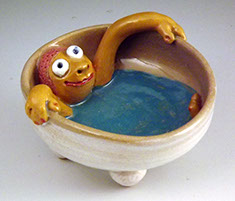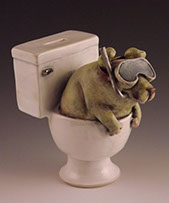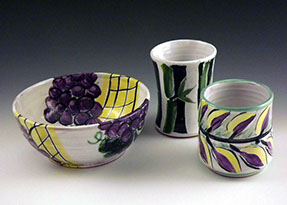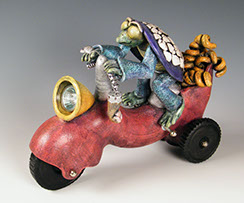Under the Scope




PAM EISENMANN
Pam was juried into Scope in 2015. Her extensive background teaching art in public schools and ceramics in university and community centers, as well as serving as Army Arts and Crafts program manager (Korea, Germany, US) give Scope artists and gallery visitors a great resource and perspective on a range of art issues. Based on her experience as an Occupational Safety and Health program manager for the Smithsonian Museums from 1991-2010, Pam is able to assist with gallery safety and provide technical expertise for Scope’s many exhibits.
But, it is her ceramic pieces that add a special dimension to the gallery. They make people smile! Her sense of humor combined with immense technical skill result in wonderful works of art, including her unique animal images. Much of her work focuses on whimsical treatments of animals and she has produced a whole collection of “fantasy lives of pets.” She confesses to loving the funny papers and finds them a source of inspiration. She also finds humor in everyday life. An ordinary soap dish is not so ordinary if Pam makes it! There is always an unexpected element—like finding a bathing beauty soaking in the dish.
To achieve her fanciful artworks, Pam starts with wheel-thrown parts, which she assembles, adding pinched and pieced bits of clay to flesh out features and appendages. Her clay is usually a mid-range white stoneware, fired to cone 7 (about 2260 F). B-Mix 5 works very well for assemblages as it is less susceptible to cracking than porcelains. For more surface interest under glazes, she also uses Miller 50, a speckled clay. She incorporates her expertise in non-traditional surfacing techniques applying different types of finishes to her figures. These non-traditional finishes, also called “cold finishes,” include using non-ceramic materials. A “skin” of black acrylic wash is applied to bisqueware that has been fired to cone 04 (about 1940 F) in an electric kiln, followed with a “canvas” of dry-brushed white acrylic. Then she layers colored acrylic, patinas, inks, and organic materials to build color and depth on her non-functional pieces. No additional firing takes place.
Pam also specializes in majolica techniques. Majolica originated in the Middle East in the 9th c. but is most associated with Italy and Spain. Ware made using these techniques was imported to Italy in the 13th c. through the Isle of Majorica, and the Italians started calling it “majolica.” They soon became experts at copying the technique and majolica ware came into prominence during the Italian Renaissance.
Majolica ware is recognized for its brightly colored decoration. A low-fire white tin-based glaze is applied to earthenware bisque- fired to cone 04. Ceramic colorants are painted onto the raw glaze. Pam uses either a combination of Mason stain and frit or commercial underglaze colors. Pieces are then glaze-fired to cone 04 or 05 in an electric kiln. Since the glaze is viscous and does not move in the glaze firing, bright, crisp lines and details can be achieved. Although Pam uses this type of surface decoration on some of her animal creations, she likes to apply this technique to other unconventional shapes and forms, including functional vessels. Vessels made using this technique are food safe
If you want to know more about Pam’s techniques, she teaches all of this at the Workhouse Arts Center, Lorton, VA where she has her studio.
Pam’s work appears in Bridgette Martin’s book, “Humor in Craft,” published in 2012, and she has been accepted into numerous exhibitions, not only locally, but nationwide, most recently for “Menagerie,” at Baltimore Clayworks, 2016, and at the “Clay 3 National Juried Ceramic Exhibition,” in Warrenville, Il., 2014.
For more of Pam’s work, visit Workhouse Art Center’s galleries, Art a La Carte in Occoquan, and Manassas Clay, or better yet, come to Scope!
Scope Gallery
Torpedo Factory Art Center
105 N. Union St.
Ground Floor, Studio 19
Alexandria, Va 22314
Phone: 703-548-6288
Winter 2022 Hours:
11:00 a.m. - 5:30 p.m. Thursday - Sunday
Check the Torpedo Factory website for any changes to the building open hours. www.torpedofactory.org/todays-hours/

